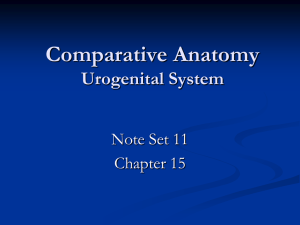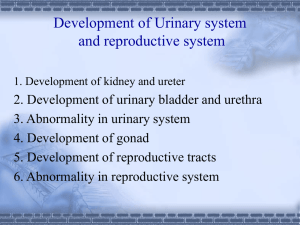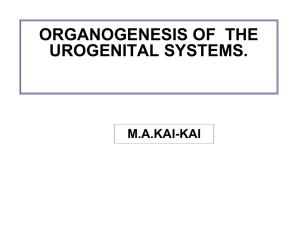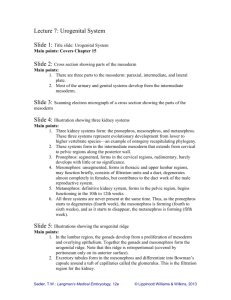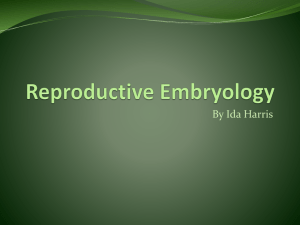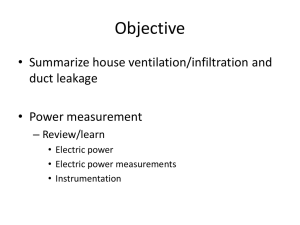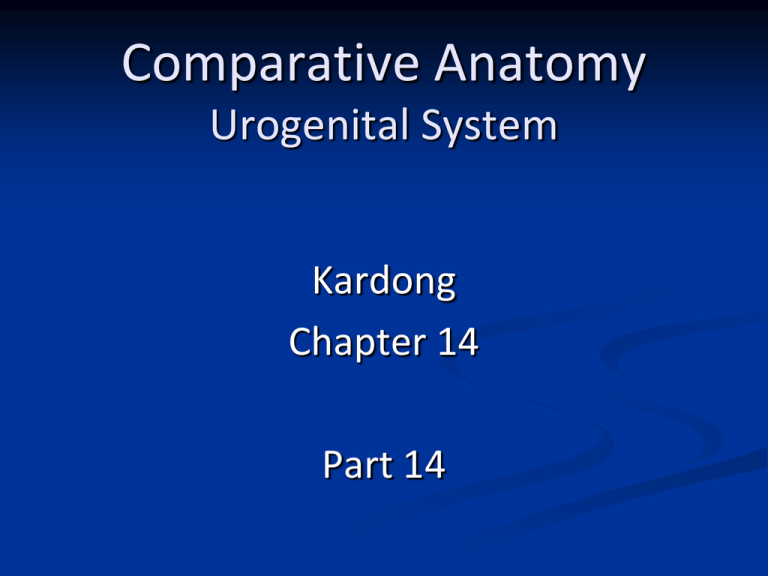
Comparative Anatomy
Urogenital System
Kardong
Chapter 14
Part 14
Urogenital System
Ducts of excretory and reproductive
systems are intimately associated
with each other
Figure 14.1. Embryonic
origin of the kidneys (book
figure 14.4).
Figure 14.2. Evolutionary development of
kidneys in vertebrates.
Primitive Kidney
Archinephros- primitive excretory kidney
organ
Holonephric concept - (3 kidneys are a
part of one organ)
Filtration system
Archinephric duct- drains to cloaca or
bladder
Figure 14.3. Hypothetical archinephros.
Primitive Kidney (cont.)
Pronephros
1st tubules to appear
Anteriorly located; head kidney
Involutes to form lymphoidal mass
Only functions temporarily
All tubules associated with pronephros
Pronephric (archinephric) duct drains pronephros
Figure 14.4. Three-part
kidney (book figure
14.5).
Figure 14.5. Pronephros –
anterior region of primitive
kidney.
Kidney Structure (cont.)
Figure 14.6. Fate of nephrogenic mesoderm (red).
Figure 14.7. Pronephric,
mesonephric, and metanephric
system relationships (see book
figure 14.6).
Kidney Structure (cont.)
Mesonephros (opisthonephros)- kidney
mass caudal to pronephric region
Functional adult kidney of fish and
amphibians
Opisthonephros - in most adult
amphibians and fishes.
Drained by mesonephric
(archinephric) duct
Figure 14.8. Mesonephros of
urodeles (see book figure 14.8)
Figure 14.9. Mesonephric duct of
opossum embryo.
Urogenital Anatomy
Ductus efferens:
Pronephric duct
Mesonephric duct
Archinephric duct (=
wolffian duct)
Anterior portion of
mesonephric tubules used in
male reproductive system
Figure 14.10. Urogenital system and adrenal
glands of male frog.
Urogenital Anatomy (cont.)
Figure 14.11. Mesonephric kidneys with mesonephric duct (black) carrying sperm
and/or urine (see book figure 14.24).
Urogenital Anatomy (cont.)
Accessory urinary ducts
Tubules also in reproductive sys.
Path for sperm to enter mesonephric duct (sperm duct)
Figure 14.12. Mesonephric kidneys with separate sperm duct (red) (see book figure 14.24).
Urogenital Anatomy (cont.)
Pronephros
Lost
Mesonephros
Mainly an embryonic kidney
Involutes at birth
Metanephric kidney
Takes over functions of mesonephros
Ureter- new duct drains meta. kidney
Figure 14.13. Metanephric
kidney assuming superior
position to remainder of
urogenital system.
Urogenital Anatomy (cont.)
Mesonephric duct
Sperm duct in males
Ductus deferens in amphibians
Vas deferens in mammals
Terminate at cloaca
Most amniotes
Not in higher vertebrates
Figure 14.14. Male teleost, caudal end of urogenital
system.
Summary of Embryonic Amniote
Urogenital Anatomy
Pronephros involutes
Mesonephros involutes
Metanephric kidney develops
Vas deferens (sperm duct in
mammals)
Table 1. Terminology of
the urogenital system (book
Figure 14.21).
Urinary Bladder
Found in most vertebrates
Formation varies
Fish- terminal segment of mesonephric duct
Large bladders- turtles and lizards
Turtles- accessory bladder
Figure 14.15. Evolution of the urinary bladder (book figure 14.53).
Gonads
Elevated ridges medial to kidneys
Gonads enlarge, suspended by
mesenteries
Mesorchium- males
Mesovarium- females
Figure 14.16. Urogenital ridge
in developing embryo (book
figure 14.18).
Figure 14.17. Ovary of hagfish (book figure 14.23).
Gonads (cont.)
Bidder’s organ
Rudimentary ovary of toads (genus
Anaxyrus—formerly Bufo)
If testes removed, become
functional ovary
Ovotestes in fish
Both ovary and testis in lizards
Multi-lobed testis in some species of
salamanders (genus Desmognathus)
Figure 14.18. Left bidder’s organ
of male Anaxyrus.
Male Urogenital System (cont.)
Figure 14.19. Urogenital anatomy of male fishes (book figure 14.33).
Male Urogenital System (cont.)
Figure 14.20. Urogenital anatomy of tetrapod males (book figure 14.35).
Female Gonads (cont.)
Figure 14.21. Urogenital anatomy of female fishes (book figure 14.25).
Female Gonads (cont.)
Figure 14.22. Urogenital anatomy of tetrapod females (book figure 14.27).
Copulatory Organs
Claspers in cartilagenous fish
Gonopodium in teleost
Intromittent organ
Hemipenes
Single penis
Figure 14.23. Gonopodium of a male guppy.
Copulatory Organs (cont’d.)
Figure 14.24. Intromittent organs
in the chondrichthyans
(book figure 14.38).
Copulatory Organs (cont.)
Figure 14.25. Intromittent
organs in the turtles and
crocodylians (book figure 14.42).
Copulatory Organs (cont.)
Figure 14.26. Intromittent organs
in birds—domestic turkey (book
figure 14.44).
Copulatory Organs (cont.)
No copulatory organs
Sperm pocketSpermatheca in most
salamanders
Rudimentary copulatory
organ
Some amniotes
(tuatara)
Cloacal apposition
Male and female
cloacae come together
Figure 14.27. Penis in the dog
(book figure 14.45).
Cloaca
Receives digestive, reproductive, and
urinary products and tracts
No cloaca
Fish – may have three separate openings
Lost in mammals above monotremes
Cloaca subdivisions:
Coprodaeum
Urodaeum
Proctodaeum
Figure 14.28. Cloacal cavities and urogenital structures in a salamander.
Cloacal Subdivisions
Coprodeum
Receives alimentary canal
Simple columnar
Urodeum
Receives urinary and
reproductive products
Transitional epithelium
Proctodeum
Associated with excretory
Stratified squamous
Figure 14.29. Subdivisions of
cloaca shown in a lizard.
Urogenital Papilla
• Typically
found in
chondrichthyans and
squamates.
Sperm
Ureter
Ductus deferens
Figure 14.30. Urogenital papilla
in snakes.
Cloacal gland
Urogenital papilla
Cloacal cavity
Cloacal Region of a Bird
Figure 14.31. Bird cloacae (book figure 14.49).
Bird Cloaca (cont.)
Bursa of Fabricius
Lymphoid evagination off cloaca
Figure 14.32. Bursa of Fabricius
on young bird.
Figure 14.33. Histology of
Bursa of Fabricius and cloaca.
Urogenital System (cont.)
Figure 14.34. Urogenital systems
of female tetrapods (book figure
14.28).
Urogenital System (cont.)
Muellarian ducts
In males, ducts are nonfunctional
In females, ducts give rise to female
reproductive tract
Only left reproductive tract
Birds and crocodiles
Raptors have vestigial right
reproductive tract
Figure 14.35. Book
figures 14.25 and
14.27.
Reproductive Tracts of Mammals
Duplex uterus
Monotremes and marsupials
Separated female reproductive tracts
Bipartite uterus
Rabbit
Body of uterus seems unpaired, yet
has two lumens
Bicornuate uterus
Cat
Two uterine horns and single lumen
Figure 14.36. Morphology
of uteri (book figures 14.51-52).
Reproductive Tracts of Mammals
Bicornuate uterus
Cat
Two uterine horns and single
lumen
Simplex uterus
Primates
Large body and horns
(cont.)
Figures 14.37-38. Mammalian uteri; fused muellerian
ducts (blackened regions) and cloaca (red).
Reproduction
Most vertebrates require both sexes
Some vertebrates are asexual
Reproduce parthenogenetically
Some fish and lizards
Embryonic humans are asexual
Until differentiation of sexual structures
Differentiation of Sexual Structures
Figures 14.39-40. Mesonephros contributions to male and female reproductive tracts.
Differentiation of Sexual Structures in
Mammals (cont.)
Genital tubercle
Male - penis
Female - clitoris
Genital folds
Male - penis contribution
Female - labia minora
Genital swellings
Male - scrotum
Female - labia majora
Figure 14.41. External genitalia of bisexual
stage of human embryo.
Differentiation of Sexual Structures in
Mammals (cont.)
Mesonephric duct
Male - vas deferens
Female - Gartner’s duct
Muellerian duct
Male - portions are retained
Female - reproductive tract
Figure 14.42. Changes in female,
mammalian urogenital system.
Differentiation of Sexual Structures in
Mammals (cont.)
Mesonephric tubule
Male - vasa efferentia
Female - epoophoran and paraophoran
Genital ridge
Male - testes
Female - ovaries
Homologous Urogenital Structures
Figure 14.43. Homologous urogenital structures in male and female mammals.
Mechanism for Elimination of
Nitrogenous Wastes
Figure 14.44. Nitrogenous
waste excretion (book figure
14.11).

